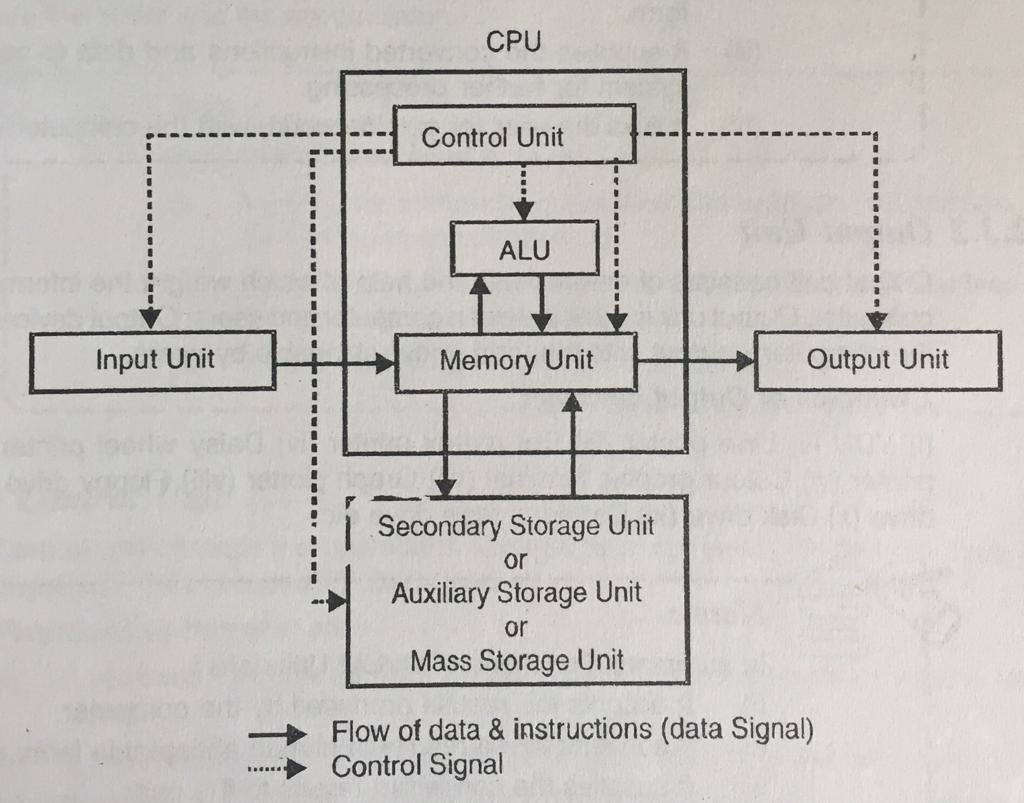Block Diagram Or Components Of Computer

Input Unit
This unit contains devices with the help of which we enter data into computer. This unit is linked between user and computer. Input devices translate the human being information into the form understandable by computer.
The input, output and storage devices are described as on-line, when they are directly connected to the CPU, when not connected directly they are described as off-line.
Example Of Input Devices
| 1 | Keyboard |
| 2 | VDU (Visual Display unit) |
| 3 | Mouse |
| 4 | Light pen |
| 5 | Scanner |
| 6 | Joystick |
| 7 | Voice recongniser |
| 8 | Card Reader |
| 9 | Digitizer |
| 10 | Floppy drive |
| 11 | Disk drive |
| 12 | Tape drive |
| 13 | Cartridge tape drive |
| 14 | OCR (Optical Character Reader) |
| 15 | OMR (Optical Mark Reader) |
Output Unit
Output unit consists of devices with the help of which we get the information from computer. Output unit is a link between computer and users. Output devices translate the computers output into the form under-standable by users.
Examples of Output devices
| 1 | VDU |
| 2 | Line printer |
| 3 | Dot matrix printer |
| 4 | Daisy wheel printer |
| 5 | Laser printer |
| 6 | Colour graphic terminal |
| 7 | Graph plotter |
| 8 | Floppy drive |
| 9 | Tape drive |
| 10 | Cartridge tape drive |
| 11 | Disk drive |
Central Processing Unit
CPU is considered as the brain of the computer. CPU perform all types of data processing operations. It stores data, intermediate results and instructions (program). It controls the operation of all parts of computer. CPU itself has following three components.
(A) ALU – This unit consists of two subsection namely: (i) Arithmetic section. (ii) Logic section
- Function of Arithmetic section is to perform arithmetic operations like addition, subtraction, multiplication & division. All complex operations are done by making repetitive use of above operations.
- Function of logic section is to perform logic operations such as comparing, selecting, matching and merging of data.
The arithmetic & logic unit contains a number of storage locations referred to as registers. These registers are composed of electronic circuitry having the capability of adding, subtracting, multiplying, rounding off etc. The number of registers in a computer vary from model to model. However, the basic registers in any computer are the adder and the accumulator.
(B) Control Unit – Control unit controls the operations of all parts of computer. It does not carry out any actual data processing operations. Functions of this unit are:
- It retrieves instructions from the main memory and determines what is to be taken.
- It then retrieves the data required to be processed from the main memory.
- It causes the CPU to actually carry out required operations and determines whether the required operations have been carried out or not.
- It places the processed results in the output area of the memory
- It fetches the next instruction from the memory and repeat the whole cycle of operations outlined above.
(C) Memory or Storage Unit – This unit can store instruction, data and intermediate results. This unit supplies information to the other units of the computer when needed. It is also known as internal storage unit or main memory or primary storage or Random access memory (RAM). Its size affects speed, power and capability. The main memory can be divided into four areas that have no fixed or built-in-physical boundaries within the memory. These areas are:
- Input storage area
- Working storage area
- Output storage area
- Program storage area.
There are two types of memories in the computer. The first type is called as primary memory and the other type is called as secondary memory. The primary memory offers temporary storage and the secondary memory provides permanent storage.


There’s definately a lot to learn about this subject. I really like all
of the points you’ve made.